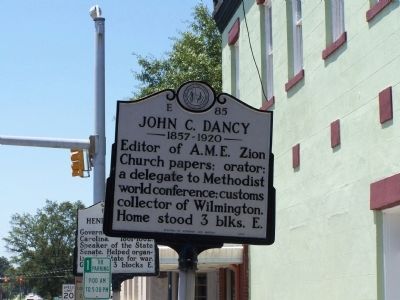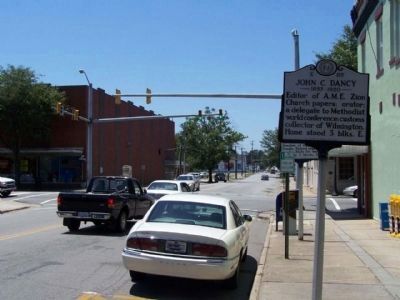Tarboro in Edgecombe County, North Carolina — The American South (South Atlantic)
John C. Dancy
1857 ~ 1920
Erected 1974 by North Carolina Office of Archives & History. (Marker Number E-85.)
Topics and series. This historical marker is listed in these topic lists: Churches & Religion • Communications. In addition, it is included in the African Methodist Episcopal Zion (AME Zion) Church, the Historically Black Colleges and Universities, and the North Carolina Division of Archives and History series lists.
Location. 35° 53.854′ N, 77° 32.062′ W. Marker is in Tarboro, North Carolina, in Edgecombe County. Marker is on West St. James Street near Main Street (Business U.S. 64). Touch for map. Marker is in this post office area: Tarboro NC 27886, United States of America. Touch for directions.
Other nearby markers. At least 8 other markers are within walking distance of this marker. W.D. Pender (a few steps from this marker); Henry T. Clark (a few steps from this marker); W.L. Saunders (a few steps from this marker); Courthouse Square (within shouting distance of this marker); Knights of Labor (about 300 feet away, measured in a direct line); The 1999 Flood (about 400 feet away); Edgecombe County Veterans Memorial (about 600 feet away); George H. White (approx. 0.2 miles away). Touch for a list and map of all markers in Tarboro.
Regarding John C. Dancy. John Dancy, prominent leader in the American Methodist Episcopal Zion Church and the Republican Party, was born in Tarboro in 1857 as the son of a freedman whose parents had been manumitted. Dancy’s father was a builder and contractor who also served as a county commissioner after the war. Dancy was educated first at home and later entered Howard University in 1873. He left school before completing his requirements due to the death of his father. Dancy returned home and began a short career as an educator since he soon became involved in politics.
Dancy served in various political capacities throughout his lifetime, most notably as a participant in activities of the Republican Party from 1880 to 1890 as candidate for office, national convention delegate, and campaign spokesman. His most lucrative and politically important position came in 1891 when President Benjamin Harrison appointed him collector of customs for the port of Wilmington, the highest paying federal position in the state. He
served as port collector until 1893 when President Grover Cleveland replaced him; in time he was re-instated by President William McKinley. Dancy’s appointment was seen by many Democrats as another example of “negro domination” and was used as part of the racially charged 1898 election campaign. When Wilmington city government was overthrown by whites in November 1898, Dancy and other leading black officials were forced to leave town. Dancy, however, returned to the city to resume his post and served as collector until 1901, when he was appointed recorder of deeds for Washington, D.C. by President Theodore Roosevelt, working in that position until 1910.
Deeply involved in church affairs, Dancy made significant contributions through his involvement with the AME Zion Church and editorship of the church newspaper, Star of Zion, for many years. Dancy served as a trustee for Livingstone College. He died in 1920 and details of his life can be found in his son’s memoirs, Sand Against the Wind. His son shared Dancy’s commitment to public service and was active in the Detroit Urban League for many years.(North Carolina Office of Archives & History)
Additional keywords. African Methodist Episcopal Zion Church, Black Methodism
Credits. This page was last revised on November 29, 2019. It was originally submitted on August 1, 2011, by Mike Stroud of Bluffton, South Carolina. This page has been viewed 758 times since then and 26 times this year. Photos: 1, 2. submitted on August 1, 2011, by Mike Stroud of Bluffton, South Carolina.

